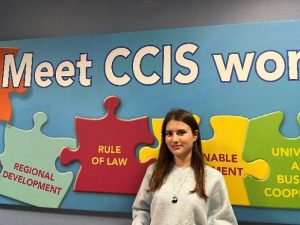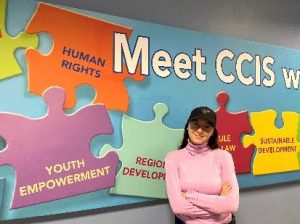Empowering Albanian Youth: Digital Rights in the AI Era
From: Mr. Alis Ahmetaj
Alis Ahmetaj is a Software Engineering senior student with a strong background in social media strategy and digital communication. Certified in Digital Marketing and an active participant in initiatives such as the Youth European Parliament and Balkan Hacking Initiative, Alis is deeply committed to advancing digital rights and international collaboration.
CCIS YOUTH OBSERVERS
January,2025
In a rapidly digitalizing world, the concept of digital rights has emerged as a cornerstone for empowering young people. In Albania, where a significant portion of the population comprises youth, ensuring equitable access to digital tools, safeguarding data privacy, and fostering active participation in digital democracy are critical. Addressing these issues is not merely a technological challenge; it is a vital step in shaping an inclusive and progressive society.
Albania’s National Youth Action Plan (2023–2025) underscores the importance of bridging the digital divide, but disparities persist, particularly in rural areas. Many young people in these regions face limited access to high-speed internet and digital tools, leaving them at a disadvantage in both educational and professional opportunities. Expanding affordable internet access through public-private partnerships and providing devices to students in underserved areas are practical steps to address this gap. Such measures will not only enhance digital literacy but also contribute to creating a more equitable society.
Despite Albania’s adoption of GDPR-aligned legislation, awareness of data privacy among young people remains alarmingly low. Social media platforms, widely popular among Albanian youth, often exploit user data without transparent consent. This calls for integrating digital literacy programs into school curricula to teach privacy rights and cybersecurity fundamentals. NGOs can also play a pivotal role in launching nationwide campaigns to educate youth on responsible data sharing and the implications of their digital footprints.
Youth engagement in digital democracy is another pressing issue. Platforms like E-Albania and Open Data Albania offer tools for citizen participation, yet many young people find them inaccessible or unappealing. Simplifying these platforms to make them more youth-friendly and incorporating interactive tools like gamified participatory budgeting can foster greater involvement. Such innovations would enable young Albanians to contribute meaningfully to policymaking and hold governmental actions accountable.
Young people in Albania hold immense potential to shape their digital future. They are not just passive consumers of technology but can be powerful advocates for stronger digital rights policies. By developing skills in AI, coding, and cybersecurity through local workshops and online platforms, they can actively contribute to a more inclusive digital landscape. Furthermore, collaborating with policymakers to address issues like digital inclusion and data privacy can ensure that their voices are heard and acted upon.
As Albania continues its digital transformation, significant challenges remain. Bridging the digital divide, strengthening data privacy, and promoting ethical AI practices are essential steps toward creating an inclusive digital environment. However, the journey doesn’t end there. Youth, policymakers, and civil society must work together to build a digital ecosystem where technology serves as a tool for empowerment rather than exclusion.
Investing in digital rights and AI education, Albania can nurture a generation of informed and active digital citizens. These young leaders will not only shape the nation’s digital future but also contribute to a brighter and more equitable tomorrow.
Citations
- National Youth Action Plan (2023-2025)
- GDPR Overview
- UN Guiding Principles on Business and Human Rights
Keywords: Digital Rights, Youth Empowerment, AI
_________________________________________
*This article is produced in the framework of the ERASMUS-YOUTH-2023-CB: A cross regional predictive model for youth policy shaping – Youth Observers. Funded by the European Union. Views and opinions expressed are however those of the author(s) only and do not necessarily reflect those of the European Union or European Education and Culture Executive Agency. Neither the European Union nor the granting authority can be held responsible for them.
© Y-O Model
All rights reserved.





